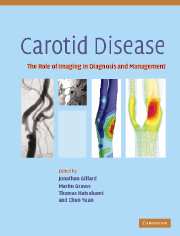Book contents
- Frontmatter
- Contents
- List of contributors
- List of abbreviations
- Introduction
- Background
- Luminal imaging techniques
- Morphological plaque imaging
- 14 MR plaque imaging
- 15 CT plaque imaging
- 16 Assessment of carotid plaque with conventional ultrasound
- 17 Assessment of carotid plaque with intravascular ultrasound
- 18 Image postprocessing
- Functional plaque imaging
- Plaque modelling
- Monitoring the local and distal effects of carotid interventions
- Monitoring pharmaceutical interventions
- Future directions in carotid plaque imaging
- Index
- References
18 - Image postprocessing
from Morphological plaque imaging
Published online by Cambridge University Press: 03 December 2009
- Frontmatter
- Contents
- List of contributors
- List of abbreviations
- Introduction
- Background
- Luminal imaging techniques
- Morphological plaque imaging
- 14 MR plaque imaging
- 15 CT plaque imaging
- 16 Assessment of carotid plaque with conventional ultrasound
- 17 Assessment of carotid plaque with intravascular ultrasound
- 18 Image postprocessing
- Functional plaque imaging
- Plaque modelling
- Monitoring the local and distal effects of carotid interventions
- Monitoring pharmaceutical interventions
- Future directions in carotid plaque imaging
- Index
- References
Summary
Introduction
Atherosclerosis, the disease behind heart attacks and strokes, is characterized by build-up of plaque within the intimal layer of arteries. Clinical events occur due to thrombosis, in which a clot occludes the vessel at the lesion site and embolization, in which thrombotic materials from the site of a lesion are released into the blood stream and occlude distal vessels. To date, the primary clinical indicator for risk from atherosclerotic plaque has been stenosis, expressed as a percentage reduction in the lumen diameter of the vessel. Stenosis is typically assessed by angiography or duplex ultrasound.
However, stenosis provides an incomplete picture of risk. Arteries exhibiting only moderate stenosis account for a large percentage of strokes and heart attacks. Histological studies in various vascular beds have established that features of the atherosclerotic plaque itself dictate its clinical course in cases of moderate stenosis (Falk, 1992). Specific plaque features associated with clinical risk include a fibrous cap that is thin, ruptured, or ulcerated and a large lipid-rich necrotic core (Virmani et al., 2000). Together these features define the “vulnerable plaque.”
Given the significance of vulnerable plaque for patient prognosis, considerable interest exists in developing noninvasive means to measure plaque features and provide clinical indicators that augment stenosis. Research in recent years has shown that magnetic resonance imaging (MRI) is a powerful tool for identifying plaque features in the carotid artery.
Keywords
- Type
- Chapter
- Information
- Carotid DiseaseThe Role of Imaging in Diagnosis and Management, pp. 235 - 250Publisher: Cambridge University PressPrint publication year: 2006



